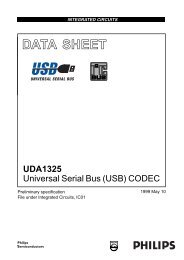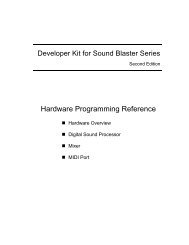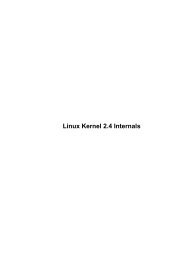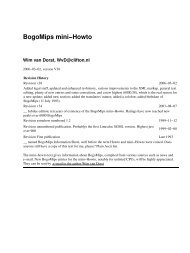Linux IP Masquerade HOWTO - The Linux Documentation Project
Linux IP Masquerade HOWTO - The Linux Documentation Project
Linux IP Masquerade HOWTO - The Linux Documentation Project
You also want an ePaper? Increase the reach of your titles
YUMPU automatically turns print PDFs into web optimized ePapers that Google loves.
your kernel. Please see Section 2.7 for URLs to the KERNEL howto, etc.<br />
• You will then have move over the kernel binary, update your bootloader (LILO, Grub, etc.), and<br />
reboot. If you have questions about kernel compiling, I highly recommend to consult some of the<br />
URLs above in this section.<br />
3.2.3. Compiling <strong>Linux</strong> 2.0.x Kernels<br />
<strong>Linux</strong> <strong>IP</strong> <strong>Masquerade</strong> <strong>HOWTO</strong><br />
Please see Section 2.8 for any required software, patches, etc.<br />
• First of all, you need the kernel source for 2.0.x (preferably the latest kernel version)<br />
♦ As the 2.0.x train progress, the compile−time options keep on changing. As of this version,<br />
this section reflects the settings for a 2.0.39 kernel.<br />
• If this is your first time compiling the kernel, don't be scared. In fact, it's rather easy and it's covered<br />
in several URLs found in Section 2.8. Please note that the instructions included here is just one way to<br />
do build a kernel. Please see the Kernel <strong>HOWTO</strong> for full details.<br />
NOTE: Please notice that it isn't recommended to put the new kernel sources into /usr/src/linux. You<br />
should leave the original kernel sources that came with your <strong>Linux</strong> distribution in /usr/src/linux. For<br />
more details on this topic, please read the "README" file in the top level directory of your kernel<br />
sources.<br />
• For this <strong>HOWTO</strong> example, create a directory called /usr/src/kernel. Next, "cd" into this<br />
directory and download the newest 2.0.x kernel sources into it. Once downloaded, issue the following<br />
command: tar xvzf linux−2.0.x.tar.gz . Please substitute the "x" in the 2.0.x filename<br />
with the <strong>Linux</strong> 2.0 kernel version you downloaded.<br />
Once uncompressed, I recommend that you rename the directory from "linux" to "linux−2.0.x" for<br />
clarity. To do this, run the command mv linux linux−2.0.x. Next, make sure there is a<br />
directory or symbolic link pointing to /usr/src/kernel/linux ie. run the command: ln −s<br />
/usr/src/kernel/linux−2.0.x /usr/src/kernel/linuxo again subsituting the "x"<br />
for your proper kernel version.<br />
• Apply any appropriate or optional patches to the kernel source code. By default, stock <strong>Linux</strong> kernels<br />
do not require any specific patching in order for the system to work. Features like <strong>IP</strong>PORTFW, PPTP,<br />
and Xwindows forwarders are optional but very useful. Please refer to Section 2.8 for URLs and the<br />
<strong>IP</strong> <strong>Masquerade</strong> Resources for up−to−date information and patch URLs.<br />
• Now that the kernel is patched up (if required), here are the MINIMUM kernel configuration options<br />
required to enable <strong>IP</strong> <strong>Masquerade</strong> functionality. Please understand that this <strong>HOWTO</strong> illustrates just<br />
ONE way to compile a kernel. <strong>The</strong> main difference from this method vs. a different one is some<br />
people wish to compile things either as modules OR monolithically right into the kernel. Basically,<br />
compiling things as modules gives you added flexibility to what is or isn't installed into the kernel<br />
(reduces unneeded memory use and allow for drop−in upgrades [no need to reboot]) BUT they add<br />
more complexity to your configuration. On the flip side, compiling things directly into the kernel<br />
makes things simpler BUT you loose a level of flexibility. <strong>The</strong> following example is a mixture of both<br />
built−in AND modules.<br />
Side Note: It is assumed that you will also configure the kernel to use your other installed hardware<br />
such as network interfaces, optional SCSI controllers, etc. as well. Please refer to the <strong>Linux</strong> Kernel<br />
<strong>HOWTO</strong> and the kernel source's "README" file and "<strong>Documentation</strong>/" directory for detailed<br />
help on compiling a kernel.<br />
Chapter 3. Setting Up <strong>IP</strong> <strong>Masquerade</strong> 31

















